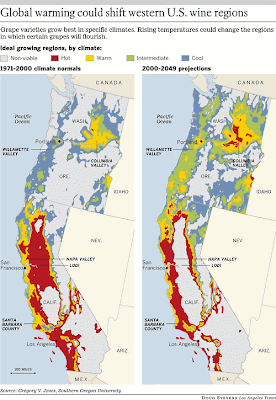 I gave a brief talk to a university group at Chateau Ste Michelle in Woodinville, Washington yesterday and it gave me a chance to think at bit about the Washington wine industry in general, now with more than 500 wineries and growing, and Chateau Ste Michelle (CSM) in particular.
I gave a brief talk to a university group at Chateau Ste Michelle in Woodinville, Washington yesterday and it gave me a chance to think at bit about the Washington wine industry in general, now with more than 500 wineries and growing, and Chateau Ste Michelle (CSM) in particular.Sue and I were fortunate to be able to spend a couple hours in the afternoon with CSM Enologist David Rosenthal (pictured here) , who is a 2001 marine biology graduate of the university. He's worked at Mondavi as a chemist and at Oregon and Australia wineries and he now helps make the white wines at CSM. They produce about 400,000 cases of Chardonnay and 750,000 cases of Riesling in addition to smaller amounts of other white varietals. It is quite an operation and David was nice enough to answer all of our questions and take us through the cellar room, sampling wines starting from unfermented juice that had just arrived from Eastern Washington on through the various stages of fermentation and aging. I learned a lot -- thanks, David.
I've read that CSM uses its large scale wisely, treating size as a resource that permits experimentation and diversity, and I could see this pretty consistently through our tour with David. CSM's scale is tailored to give its winemakers a great deal of choice when it comes to blending their high volume wines and also to facilitate limited production products, including of course the single vineyard bottlings.

Chateau Ste Michelle is part of Ste Michelle Wine Estates (SMWE), which owns several other Washington brands, including Columbia Crest, Snoqualmie, Domaine Ste. Michelle (sparkling wines), NorthStar (which began as a high end merlot specialist label), Red Diamond, Stimsom Estates Cellars (up-market jug wines), 14 Hands (the manditory critter wine -- the critter on the label is a horse that stands 14 hands high) and the boutique Walla Walla producer Spring Valley Vineyard. If you've been reading this blog you know how important brands are in the wine market today and SMWE's strategy reminds me of the old Robert Mondavi company -- to have competitive brands from the popular premium shelf on up to the icon level, leaving the low margin bulk wine market (the bottom shelf) to Gallo, Yellowtale and Charles Shaw. CSM and Columbia Crest are the leading brands, with 3 million cases produced between them.
Although everyone associates CSM with Washington, the company's reach is much broader. Other brands in their stable include Erath (Oregon), Villa Mt. Eden and Conn Creek (Napa Valley) and Distant Bay (Monterey). They are the exclusive U.S. distributors of Antinori wines and have partnerships with both the Antinori family (to produce Col Solare, Washington's answer to Opus One) and, with the Mosel's famous winemaker Ernst Loosen (to make Eroica, an exceptional Riesling). SMWE is the largest producer of Riesling wines in the U.S. and possibly in the world! Together with the Antinoris, SMWE recently purchased Stag's Leap Cellars in Napa Valley, one America's most distinguished wineries.
In other words, this is big business, both in terms of volume and quality. Altogehter SMWE's brands produce 4 million cases a year, which is about two-thirds of all Washington wine, and it is a correspondingly huge influence on the whole industry here. Of course, Washington is still tiny, in quantity terms, compared to California. People say that Gallo produces about 70 million cases all by itself. (Since Gallo is family-owned, it doesn't report as much data as publicly-traded wine producers do, so we have to guess what's going on in the big warehouses in Modesto.)
 SMWE makes a lot of very good wine, which is perhaps more important that quantity in today's market. SMWE's brands account for the largest number of Wine Spectator 90+ wines (and the most total top 100 wines) of any producer in the world. It is an interesting fact that Washington doesn't compete at all at the very bottom rung of wine ladder -- the very inexpensive bulk wines that account for much of the total volume in today's market. You know what I am talking about -- Two Buck Chuck and the lesser wines that make that brand look so good. Of all the New World wine regions, only Washington and New Zealand have been able to build a wine industry from the popular premium level up.
SMWE makes a lot of very good wine, which is perhaps more important that quantity in today's market. SMWE's brands account for the largest number of Wine Spectator 90+ wines (and the most total top 100 wines) of any producer in the world. It is an interesting fact that Washington doesn't compete at all at the very bottom rung of wine ladder -- the very inexpensive bulk wines that account for much of the total volume in today's market. You know what I am talking about -- Two Buck Chuck and the lesser wines that make that brand look so good. Of all the New World wine regions, only Washington and New Zealand have been able to build a wine industry from the popular premium level up.But it makes sense: Washington cannot hope to compete with California's Central Valley producers when it comes to cost-sensitive bulk wines, so it doesn't try. New Zealand is in the same position with respect to Australia. In both cases, I believe, this actually works to the smaller, higher-cost producer's ultimate benefit, since all of the focus is on quality and on the growing upper-tier of the market.







